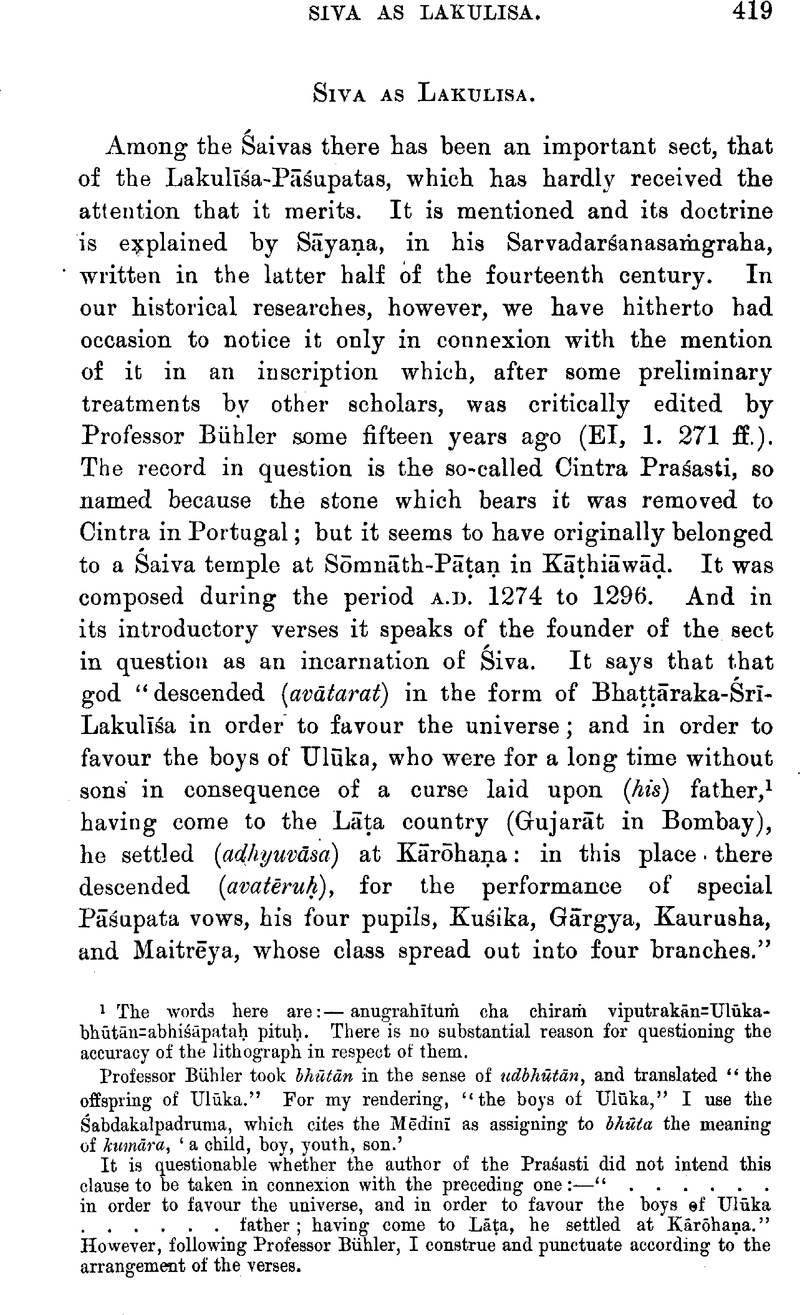
page 419 note 1 The words here are:— anugrahïtuṁ cha chiraṁ viputrakān=Ulūkabhūtān=abhiśapataḥ pituḥ. There is no substantial reason for questioning the accuracy of the lithograph in respect of them.
Professor Bühler took bhūtān in the sense of udbhūtān, and translated “the offspring of Ulūka.” For my rendering, “the boys of Ulūka,” I use the Śabdakalpadruma, which cites the Mēdinī as assigning to bhūta the meaning of kumāra, ‘a child, boy, youth, son.’
It is questionable whether the author of the Praśasti did not intend this clause to be taken in connexion with the preceding one:—“……in order to favour the universe, and in order to favour the boys ef Ulūka …… father; having come to Lāṭa, he settled at Kārōhaṇa.” However, following Professor Bühler, I construe and punctuate according to the arrangement of the verses.
page 420 note 1 The word lakula, of which we have also the variants lakuḷa, lakuṭa, lagnḍa, and apparently lagura, means ‘a cluh.’ The name Lakulin means ‘he who has or carries a club.’ The name Lakulīśa, Lakulīśvara, means 'Īśa, Īśvara (the lord, Śiva), as he who has or carries a club.’ With a not infrequent interchange of l and n, the name sometimes appears as Nakulīśvara (e.g., PSOCI, No. 189, line 25); and Nakulin is the form given in the two published texts of the Vāyu-Purāṇa, and the Sarvadarśanasaṁgraha seems to give Nakulīśa. The doctrine is mentioned in inscriptions as the Lākulāgama and Lākulasiddhānta.
The lakula of Śiva seems to be identical with his khaṭvānga, which is explained in dictionaries as ‘a club shaped like the foot of a bedstead.’ If so, evidence of the early popularity of the cult of Lakulīśa in Southern India is afforded by the fact that the Pallava kings had the khaṭvāṅga-banner: see EI, 5. 204, line 41; and H.SII, 1. 146: 2. 357, translation of verse 24.
page 422 note 1 These two names are not exactly synonymous, and seem to indicate two distinct places which subsequently became confused: Kāyāvatāra, “the (place of) descending into the (human) body,” i.e., the place where the incarnation of Śiva as Lakulīśa was manifested, the place at which the teacher Lakulin made his first appearance; Kāyārōhaṇa, “the (place of) ascending into the (divine) body,” i.e., the place at which Lakulin eventually settled, established his school, and died. And the local Māhātmya, mentioning Kārvān as Kāyavirōhaṇa, appears only to claim (see EI, 1. 274; Gazetteer of the Bombay Presidency, 7. 550) that it was there that the god disappeared when the incarnation came to an end.
A record of A.D. 706 (IA, 13. 77) mentions Kāyāvatāra as a camp of the Gurjara prince Jayabhata III., and necessarily locates the place in the same territory with Kārvān, with which in fact it was identified by Professor Bühler (IA, 18. 176). This record does not mention the incarnation. But the name itself seems to shew that the event was already localized in that neighbourhood.
page 423 note 1 Vishṇu, also, had a club, – or according to some translators a mace, – called in his case gadā. And according to Varāhamihira the rule was that, if he was to be represented as four-armed or eight-armed, the club should be in one of his right hands; if he was to be represented as two-armed, the club seems to have been omitted: see the Bṛihat-Samhitā, 58/57. 31 to 35. For Śiva, whom he treats only as two-armed, Varāhamihira mentions (verse 43) only the trident and the bow Pināka.
A good illustration of the club of Vishṇu has been given by Dr. Burgess in his photograph of the Narasiṁha form as shewn in the Bādāmi Cave No. 3 j see ASWI, 1. plate 29. There, however, the god is represented with one of his left arms leaning on the club. And the sculptures at the top of. an inscription at Baḷagāmi (PSOCI, No. 183) shew Vishṇu, as Kēśava, holding the club downwards in one of his left hands.